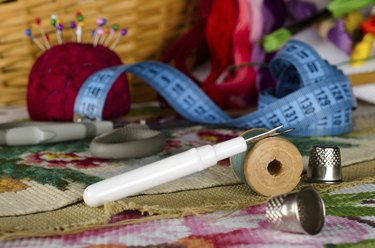Things You'll Need
Ruler
Seam ripper
Fusible interfacing
Scissors
Iron
Pins
Thread that matches the original hem thread
Sewing machine

Whether it's a heavy pair of jeans, a summery knit sundress, or a pair of child's woven pants, a hem that rolls up is both annoying and unsightly. Hems that roll can cause fraying in the hem itself and often make your outfit look uneven at the bottom. While some hems start rolling before you ever put the item on, most don't start until after being washed and worn several times. You can reinforce your hem so that it resists rolls and stay straight and flat.
Step 1
Turn your garment inside out. Use your ruler to measure the distance from the bottom edge of your hem to the hem seam to find your seam allowance. Write down this seam allowance.
Video of the Day
Step 2
Use the seam ripper to remove the hem seam completely. Remove all excess threads and unfold the hem completely.
Step 3
Set your iron at an appropriate setting for your garment. Iron the hemmed area to remove any wrinkles the curling has made.
Step 4
Select an fusible interfacing appropriate for the weight of your fabric. For jeans and heavier fabrics, use a medium-weight nonwoven interfacing. For cottons and lighter fabrics, use a lightweight nonwoven interfacing.
Step 5
Measure the height of your hem from the bottom unfolded edge to the hem fold. Cut a strip of interfacing as long as the bottom edge of your hem and approximately twice as wide as the height measurement you just took of your hem.
Step 6
Following the manufacturer's instructions, fuse the interfacing to the wrong side of the hem of your garment so that it rests on the very bottom, unfolded, raw edge of the hem. Your entire hem should have a layer of the interfacing fused to it.
Step 7
Refold the hem up along its original hem fold lines; take your time, as the interfacing may make it difficult to fold. Iron the hem fold into place. Pin the hem into place.
Step 8
Thread your sewing machine with thread that matches your original hem thread. Sew your hem into place using a seam allowance equal to the original seam allowance you measured. Remove your pins. The interfacing will keep your hem in place and protect it from curling.
Tip
If you do not want to use interfacing or undo the original hem, an alternative method to keep the hem from rolling is to trim off all the excess fabric inside and then do a top stitch above the original hem with a twin needle and the same type of thread originally used on the garment. This helps keep it flat and also eliminates the need to iron the garment after every wash.
Video of the Day